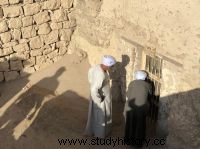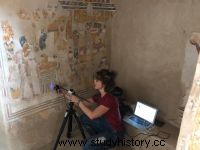For this 16 e episode of the notebooks of Egypt, the observation of the very unusual representation of a palette in the tomb of Ipouky and Nebamon in Luxor leads to reflection on the objects used by the artists and the concepts which may have governed their choices of painting .
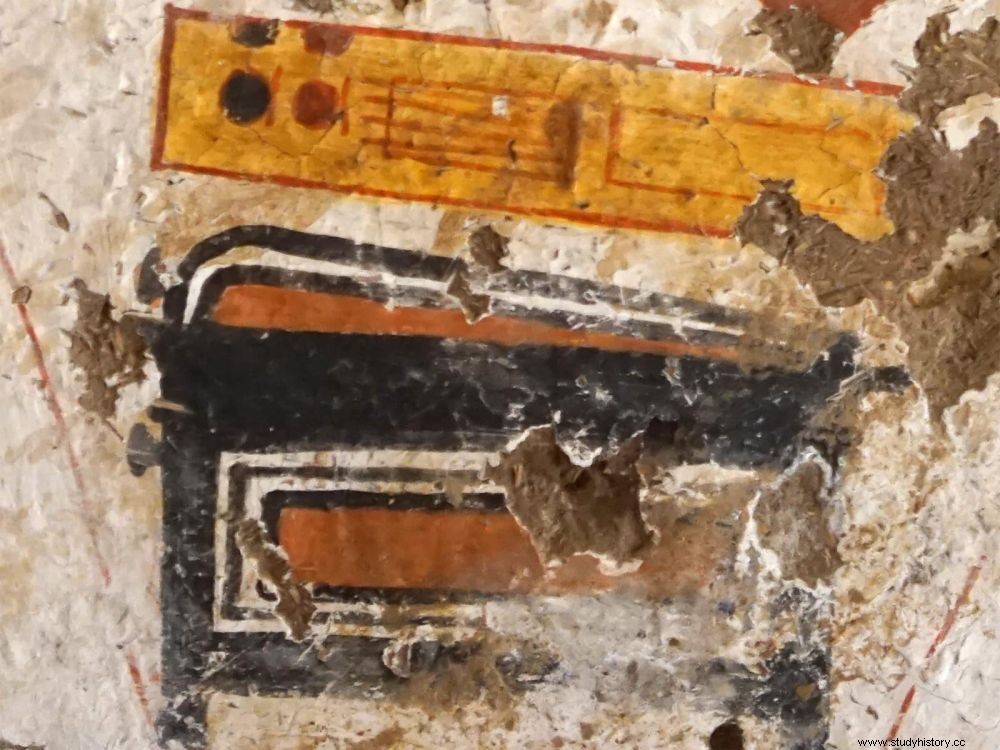
Scribe's palette and box, Tomb of Ipuky and Nebamon, Luxor
The tomb of Ipuky and Nebamon contains a curious representation of a scribe's palette:it represents the object with reeds and two buckets which contain the colors red and black. But these buckets appear to be painted viewed from above and from the side in a kind of Cubist-like depiction that differs from models discovered during excavations or depicted elsewhere.
A scribe's palette that appears to be depicted in a cubist manner
The scribe's palette is indeed generally depicted with the two black and red inks, those used for writing hieroglyphs or hieratic texts on papyrus. Red was used for headings such as titles and headings to distinguish them from the rest of the text, written in black. The excavations have also made it possible to find such objects which sometimes still contain the pigments. Black was made by burning organic materials to produce soot and its binder was usually gum arabic. This ink is very stable, does not fade or alter the papyrus. Red is composed of an earth rich in iron oxide.
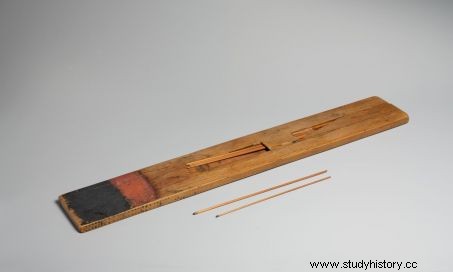
Palette in the name of Smendes, High Priest of Amun, 3 e middle period (around 1000 BCE). ©Metropolitan Museum of New York.
Other palettes show the existence of more complex objects which are more related to the painter's work on papyrus, wood, ostraca (a shard of pottery or a shard of limestone used as a writing medium) and possibly on the walls, even if the quantities present seem insufficient for such an activity. They then contain a greater number of wells and usually the following colors:blue, green, yellow, red, black and white. In some cases, a color is missing or another seems to be present twice, without really knowing why.
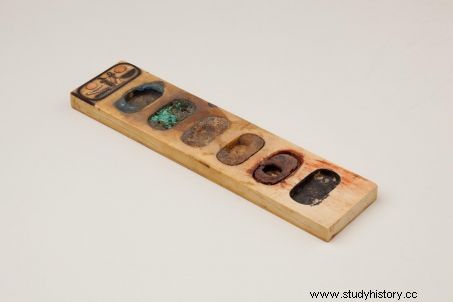
Ivory palette with 6 color pans. The oval cartouche is in the royal name of Amenhotep III, "Nebmaâtrê Mérienrê", i.e. "Rê is the possessor [Master] of justice, Beloved of Rê", 14 e century BC, ©Metropolitan Museum of New York
The colors of the palette are also present in "decorative bands" that surround the scenes
The murals of the funerary chapels present friezes which delimit the various scenes and which also present the palette of colors of ancient Egypt. They are composed of continuous lines and a series of rectangles of blue, yellow, red and green colors, separated by white areas and black lines. These frames are an opportunity for researchers because they make it possible to identify unmixed, pure colors, i.e. those that were present in the artists' paint cans.
In the tomb of Ipouky and Nebamon (Valley of the Nobles, Luxor), X-ray fluorescence spectrometry analyzes show that green and blue colors (Egyptian blue and Egyptian green) contain the same amount of arsenic impurity, i.e. 0.35%, in the copper introduced to manufacture these pigments. This shows that the source of the metal essential for the synthesis of these colors had to be the same. In the tomb of Amenouahsou, dated to a slightly more recent period, the impurity of arsenic is only 0.05% of the amount of copper:another metal or another purification treatment of the ore has been employee.
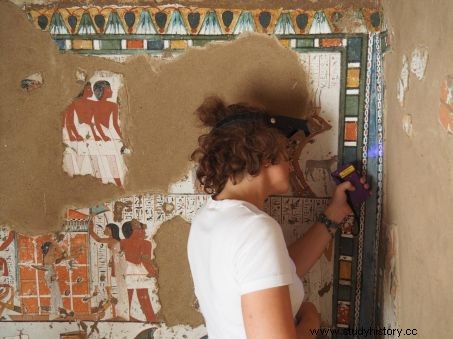
Catherine Defeyt, researcher at the University of Liège, observing the frames of the scenes with an ultraviolet lamp, tomb of Ipouky and Nebamon ©MAFTO-LAMS CNRS
These various elements of decoration and these artists' tools evoke other considerations for Helen Glanville, member of the interdisciplinary team which studies these Egyptian paintings in Luxor and specialist in the techniques of art - in particular that of Nicolas Poussin - in the laboratory. of Molecular and Structural Archeology (Sorbonne University - CNRS):"What we perceive as decorative bands, carries, in an order that seems to be always the same, the colors of this ordered world:blue and yellow, then green and red. These will be 'pairs' of colors to which scientists will give the name of complementary colors a few thousand years later and which have gone through the history of art. Also the fact that the craftsman or the Egyptian artist rigorously put a white undercoat under the reds and not under the yellows demonstrates a deliberate choice that must have had a specific purpose. It will be necessary to investigate a larger number of decorated tombs to understand whether it was an individual's whim or not. "
And she adds:"Talking about complementary colors and the importance of colored underpaintings in these paintings might seem like an anachronism because these concepts that take into account the complexity of our perception of the works have only been understood for a few centuries and we have no proof that Egyptian painters considered them. But we must not forget that it is not because we have not scientifically named a phenomenon that this means that we do not did not understand:Thomas Young at the beginning of the 19 th century postulated the existence of three color receptors in the eye, long before their scientific observation, and Leonardo da Vinci explained the 'reasons' for the blue color of the sky long before Raleigh and Tyndall. "
The images of the notebooks of Egypt
Notebooks of Egypt, 1st episode:how did the painters of ancient Egypt work?
Notebooks from Egypt, 2nd episode:Discovering the funeral chapel of Nakhtamon.
Notebooks from Egypt, 3rd episode:The pigments of Egyptian painting.
Notebooks from Egypt, 4th episode:The modern documentation of painted walls.
Notebooks from Egypt, 5th episode:Rediscovering the monuments of eternity of Ramses II.
Notebooks from Egypt, 6th episode:Revealing pigments with light:the visible and the invisible.
Notebooks from Egypt, 7th episode:Experiencing research through images.
Notebooks of Egypt, 8th episode:Beginning of the study of the paintings of the tomb of Nebamon and Ipouky.
Notebooks from Egypt, 9th episode:A tomb shared by two artists under Amenhotep III.
Notebooks from Egypt, 10th episode:What the tomb of Amenouahsou, an artist from ancient Egypt, reveals.
Notebooks from Egypt, 11th episode:Strange uses that have been made of Egyptian mummies.
Notebooks from Egypt, 12th episode:"Why don't all the artists come here?"
Notebooks of Egypt, 13th episode:Why did the Egyptians draw the characters in profile?
Notebooks from Egypt, 14th episode:Observing craft practices in Egyptian tombs.
Notebooks from Egypt, 15th episode:About Egyptian perfumes.
Notebooks from Egypt, 16th episode:The colors of the Egyptian palette.
Notebooks of Egypt, 17th episode:The Egyptian language does not know a word to designate "art".
Notebooks of Egypt, 18th episode:The day of a scientific mission in Egypt.


